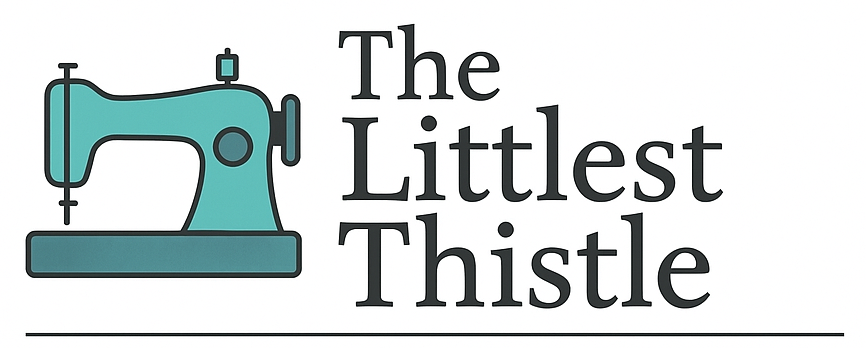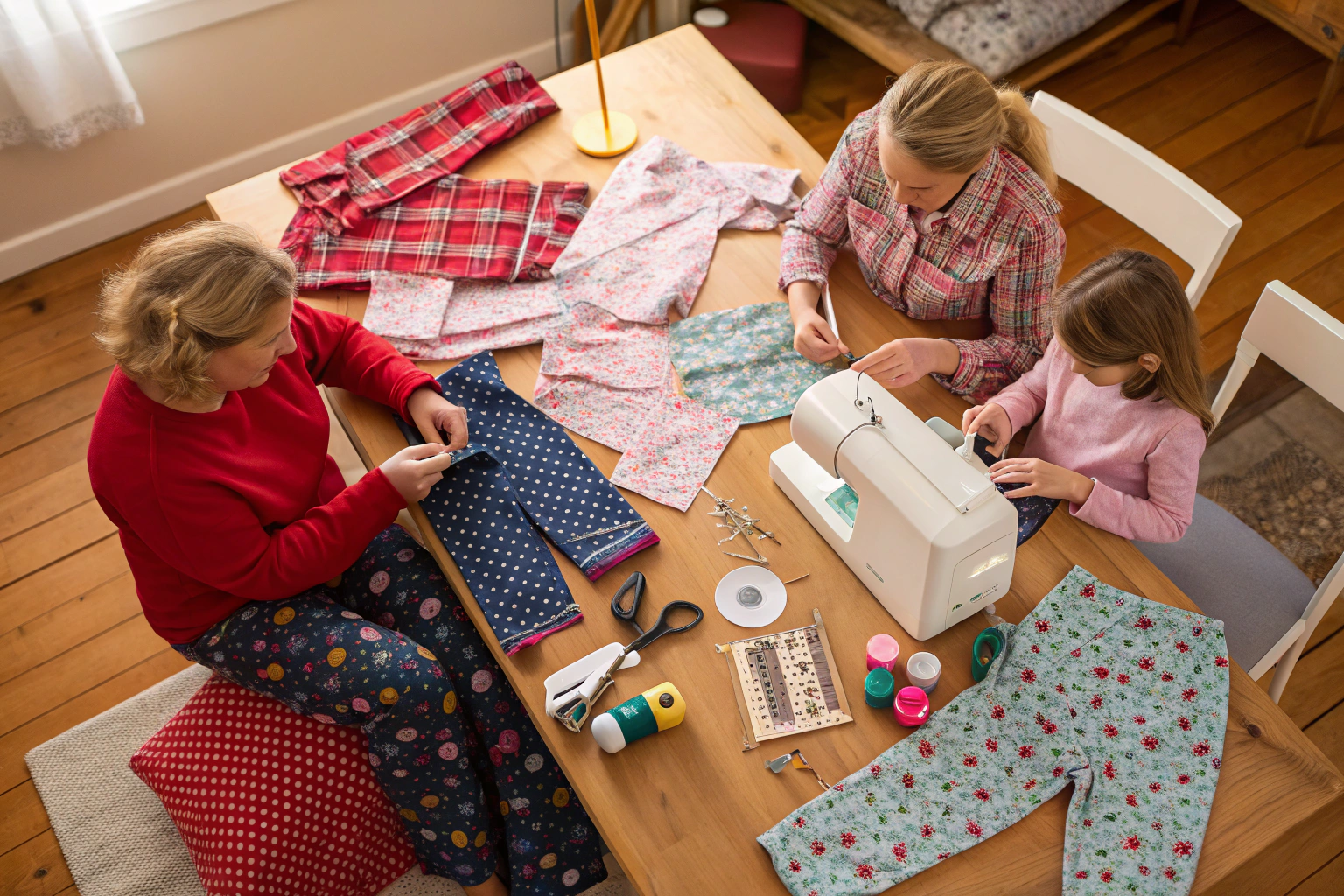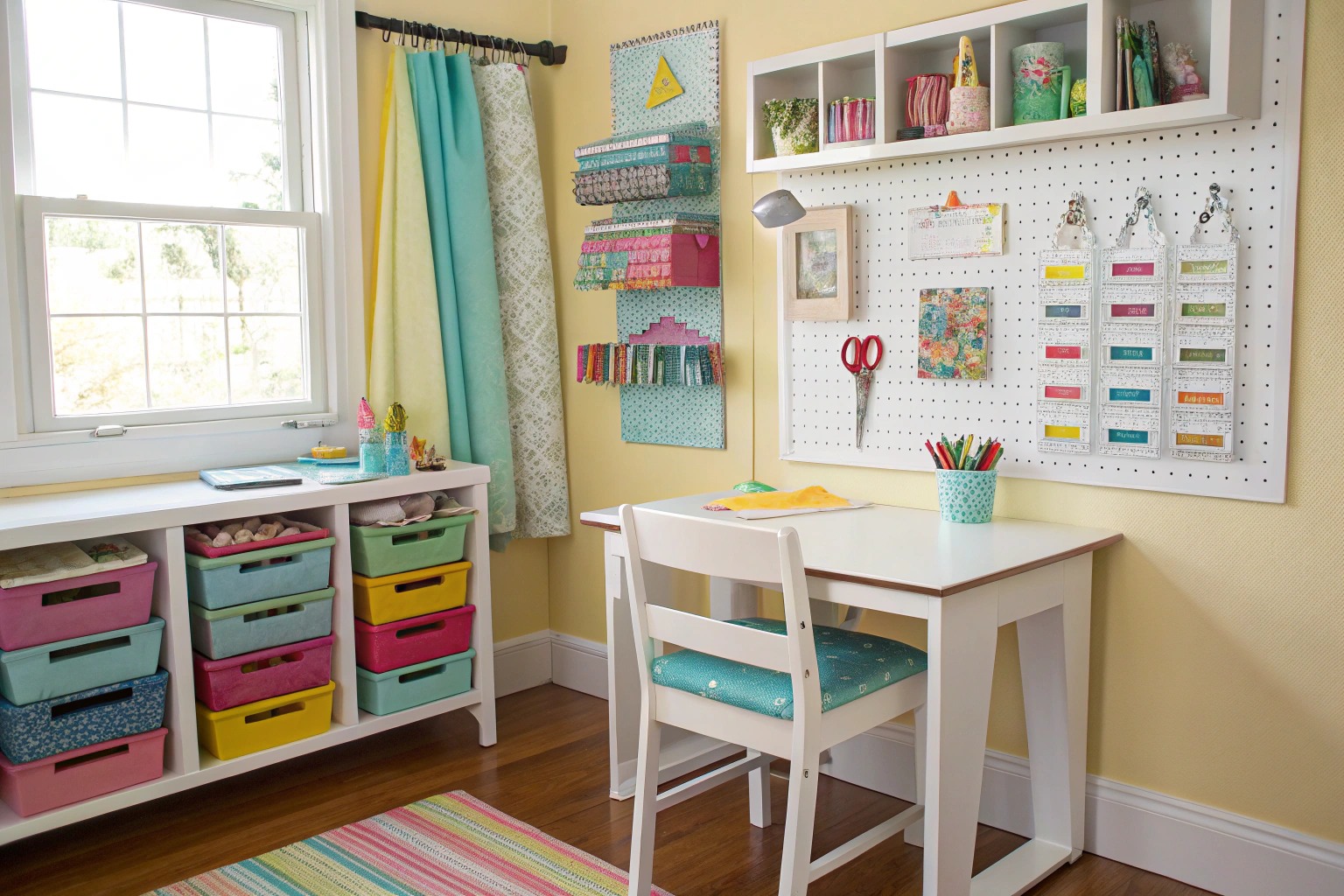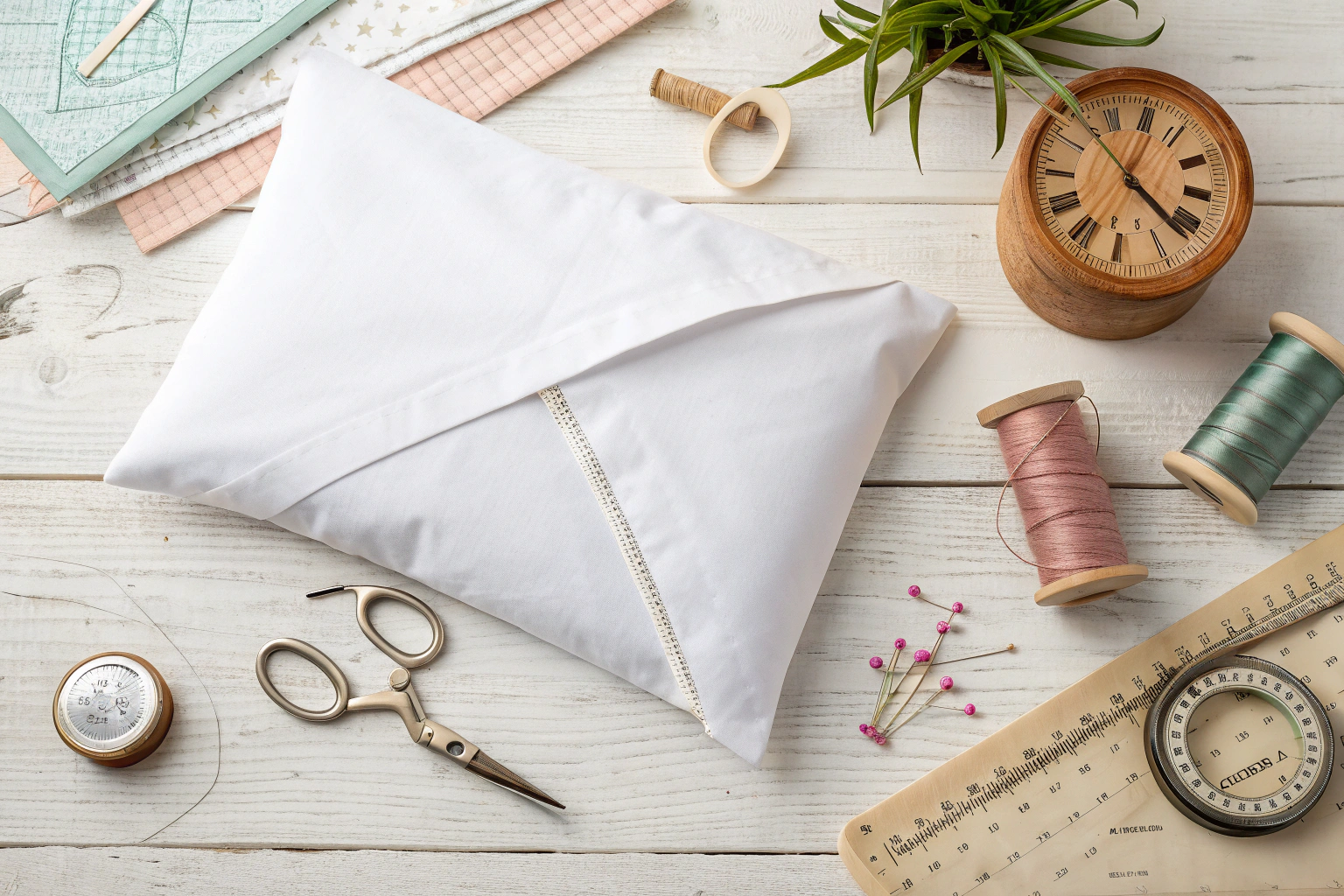A family project: sewing pajamas together is a wonderful, collaborative activity where family members of all ages create personalized sleepwear. This hands-on experience is perfect for bonding, teaching valuable life skills, and creating cherished memories and garments. Success often hinges on choosing a beginner-friendly pattern and assigning tasks appropriate for each person’s skill level, turning a simple craft into a fun, shared accomplishment that everyone can enjoy wearing.
Key Benefits at a Glance
- Builds Practical Skills: Teaches kids and adults valuable life skills like measuring, cutting fabric, and basic machine or hand sewing in a low-pressure environment.
- Strengthens Family Bonds: Working together on a shared creative goal fosters communication, teamwork, and creates fun, lasting memories away from screens.
- Creates Custom-Fit Comfort: Make pajamas that fit everyone perfectly using soft, breathable fabrics like cotton or flannel that you choose yourself.
- Accessible for All Ages: Simple pajama patterns can be easily adapted, allowing even young children to help with tasks like pinning, choosing buttons, or decorating.
- Makes a Meaningful Keepsake: The finished pajamas serve as a tangible and cozy reminder of the quality time your family spent creating something together.
Purpose of this guide
This guide is for families, including sewing beginners, looking for a meaningful and creative activity to do together. It solves the common challenge of planning a group project by providing clear direction to ensure the process is enjoyable rather than frustrating. You will learn how to select simple, forgiving pajama patterns, choose comfortable fabrics, and divide tasks fairly among different ages and skill levels. By following these tips, you can avoid common mistakes like picking an overly complex design and ensure your family sewing project results in cozy pajamas and happy memories.
Key Takeaways
- Pajamas are forgiving garments perfect for beginner sewers
- Family sewing builds patience, problem-solving skills, and relationships
- Projects can be adapted for ages 3+ with appropriate task division
- No commercial patterns needed – existing clothes work as templates
- Creates meaningful annual tradition with lasting memories
Introduction
As a sewing instructor with over fifteen years of experience guiding families through crafting projects, I've discovered that creating pajamas together offers the perfect blend of skill-building and relationship strengthening. This collaborative project transforms ordinary fabric into cherished sleepwear while weaving precious memories that last far beyond the final stitch.
Why Pajamas Make the Perfect Family Sewing Project
“Sewing matching pajamas for the holidays is growing in popularity, with 64% of families reporting making or buying sets together for festive events in 2024.”
— Straight Stitch Designs, January 2024
Source link
Pajamas represent the ideal entry point for family sewing projects because they embrace imperfection while delivering maximum satisfaction. Unlike fitted garments that demand precise measurements and complex alterations, pajamas thrive on comfort and ease, making them naturally forgiving for beginning sewers. The loose-fitting nature means minor measurement errors become features rather than flaws, while simple construction techniques like elastic waistbands and basic seams provide achievable goals for every skill level.
The practical nature of pajamas ensures your family's hard work won't languish in a closet unused. Every night becomes a celebration of your collective achievement, reinforcing the value of handmade items and the satisfaction of creating something truly useful. My own family still talks about the pride they felt wearing their first handmade pajamas to a holiday gathering, where relatives marveled at both the coordinated look and the obvious joy radiating from each family member.
Benefits of Family Sewing Projects
- Develops patience and focus in children
- Builds practical life skills across generations
- Creates screen-free quality time together
- Encourages problem-solving and creativity
- Instills pride in handmade accomplishments
- Strengthens family bonds through shared goals
- Teaches value of creating vs consuming
Family sewing projects create unique opportunities for multi-generational skill sharing that simply cannot be replicated through individual activities. I've witnessed grandparents teaching traditional techniques to grandchildren while simultaneously learning modern shortcuts from tech-savvy teens. This reciprocal learning environment breaks down age barriers and creates mutual respect based on shared accomplishment rather than hierarchical authority.
The problem-solving aspects of sewing naturally develop critical thinking skills in children while teaching them that mistakes are opportunities for creative solutions rather than failures. When my youngest daughter accidentally cut her pajama top too short, instead of discarding the piece, we brainstormed together and created a trendy cropped style that became her favorite. This experience taught her that flexibility and creativity often lead to better outcomes than rigid adherence to original plans.
Perhaps most importantly, family sewing projects provide genuine screen-free interaction in an increasingly digital world. The tactile nature of fabric manipulation, the focus required for precise cutting, and the satisfaction of seeing tangible progress create natural conversation opportunities. During our pajama sessions, some of our most meaningful family discussions have emerged organically, facilitated by the shared activity and relaxed atmosphere that crafting together naturally creates.
Getting Started Planning Your Family Pajama Project
- Hold family meeting to gauge interest and commitment
- Assess each member’s current sewing skill level
- Set realistic timeline based on available time
- Establish project budget for materials and tools
- Choose patterns or template method
- Select coordinating fabrics for family cohesion
- Gather all necessary tools and supplies
- Set up dedicated workspace for multiple participants
Successful family pajama projects begin with honest assessment and realistic expectations rather than ambitious enthusiasm. During your initial planning meeting, discuss each family member's current skill level, available time commitment, and personal preferences for style and fabric. I've learned through experience that forcing participation or setting unrealistic timelines often leads to frustration and abandonment of the project halfway through construction.
Choose soft, breathable cotton that’s easy to sew and comfortable for sleep—just like the fabric used in flap pillowcases: How to Sew a Pillowcase with Flap.
Budget considerations extend beyond fabric costs to include necessary tools, notions, and potential pattern purchases. A typical family pajama project for four people requires approximately $80-120 in materials, depending on fabric choices and whether you need additional tools like rotary cutters or specialized presser feet. Consider this an investment in both the finished products and the shared experience, as the tools and skills acquired will serve future projects.
Timeline planning should account for the reality of family schedules and attention spans rather than optimistic projections. Our first pajama project stretched across six weeks of weekend sessions, while our most recent version was completed in two intensive vacation days. Both approaches succeeded because we matched the timeline to our family's current circumstances and energy levels, avoiding the pressure that can transform enjoyable crafting into stressful obligations.
Selecting the Right Patterns for Different Family Members
“Our PDF pattern makes it easy to sew pajamas for everyone, offering sizing for preemies up to 6X adults so every member of the family can participate and enjoy their handmade pajamas in 2025.”
— Sweet Red Poppy, April 2025
Source link
| Pattern | Difficulty | Size Range | Special Features | Cost |
|---|---|---|---|---|
| Simplicity 1504 | Beginner | XS-XL | Basic elastic waist | $15-20 |
| McCall’s M6251 | Intermediate | S-XXL | Multiple views, pockets | $18-25 |
| Seeds by Sew Pony | Beginner | 2T-14 | Child-friendly construction | $12-16 |
| No-Pattern Method | Beginner | Any size | Uses existing clothes | $0 |
Pattern selection significantly impacts both the success and enjoyment of your family pajama project, making it crucial to prioritize simplicity and clear instructions over complex design features. Commercial patterns like Simplicity 1504 offer straightforward construction with minimal fitting requirements, while children's patterns such as Seeds by Sew Pony include helpful illustrations and simplified terminology that make instruction-following accessible to younger participants.
Consider purchasing patterns that offer multiple size ranges within a single envelope, allowing you to maintain design consistency while accommodating different family members' measurements. Many modern pattern companies recognize the growing interest in family sewing projects and specifically design their pajama patterns with coordinating elements across age groups, ensuring your finished garments look intentionally matched rather than coincidentally similar.
No Pattern Pajama Option
- Select well-fitting existing pajamas or comfortable clothes
- Lay garment flat on paper or fabric
- Trace around edges with 1-inch seam allowance
- Add 2-3 inches to hem lengths for adjustability
- Mark fold lines and construction details
- Create paper template for multiple family members
- Test fit with muslin before cutting final fabric
Creating pajamas without commercial patterns offers surprising advantages for family projects, particularly when working with sewers who feel intimidated by traditional pattern symbols and terminology. This approach allows you to customize fit based on each family member's favorite existing garments while eliminating the complexity of pattern sizing and grading that can overwhelm beginning sewers.
The tracing method works exceptionally well for families with widely varying sizes, as you can create templates from each person's best-fitting sleepwear rather than trying to grade a single pattern across multiple size ranges. I've found this approach particularly successful when working with families that include both small children and plus-size adults, where commercial patterns often don't provide adequate size ranges within a single purchase.
Pattern Hacking for Different Family Members
Successful pattern modifications for family pajama projects focus on comfort and construction simplification rather than complex design changes. Simple adjustments like converting button closures to pullover styles for younger children, or adding extra ease through the hips for adult comfort, can make a single pattern work effectively for multiple family members with vastly different needs and skill levels.
The key to successful pattern hacking lies in understanding which modifications will improve both the construction process and the finished garment's wearability. For example, converting fitted sleeves to a simple rectangular shape eliminates the complexity of easing while creating a comfortable, relaxed fit that works well for sleepwear. Similarly, replacing drawstring waistbands with simple elastic casings removes the need for precise eyelet placement while creating equally functional finished garments.
Choosing Fabrics That Work for Everyone
- Cotton flannel – soft, warm, easy to sew, forgiving
- Cotton quilting fabric – stable, beginner-friendly, wide selection
- Cotton jersey knits – comfortable, stretchy, requires serger or stretch stitches
- French terry – cozy, professional look, moderate difficulty
- Cotton muslin – lightweight, breathable, excellent for practice
- Avoid: slippery fabrics, heavy materials, complex prints for beginners
Fabric selection for family pajama projects requires balancing comfort, sewability, and durability considerations while accommodating multiple skill levels working with the same materials. Cotton flannel consistently emerges as the ideal choice for beginning family sewers because it offers excellent drape, comfortable wearing properties, and forgiving construction characteristics that hide minor stitching irregularities while remaining easy to handle during cutting and sewing.
For helpful tips on choosing fabrics, see the fabric guide or explore a comprehensive pajamas overview. Consider the washing and care requirements of your chosen fabrics, as family pajamas will require frequent laundering and should maintain their comfort and appearance through repeated wash cycles. Pre-washing all fabrics becomes especially important for family projects, as you want consistent shrinkage across all garments to maintain the coordinated appearance over time.
Seasonal Fabric Selection and Ideas
| Season | Recommended Fabrics | Weight | Example Prints |
|---|---|---|---|
| Spring | Cotton voile, lightweight flannel | Light | Florals, pastels, garden themes |
| Summer | Cotton lawn, muslin, bamboo | Very light | Nautical, tropical, bright colors |
| Fall | Medium flannel, cotton twill | Medium | Leaves, pumpkins, warm tones |
| Winter | Heavy flannel, French terry | Heavy | Snowflakes, plaids, holiday themes |
Seasonal fabric selection adds an exciting dimension to family pajama projects while ensuring maximum comfort and wearability throughout the year. My family has discovered that creating pajamas for specific seasons or holidays transforms the project from a one-time activity into an eagerly anticipated annual tradition, with each family member developing preferences for certain seasonal themes or fabric weights.
Winter pajama projects offer opportunities to work with luxurious fabrics like brushed flannel or French terry that create professional-looking results while providing exceptional warmth and comfort. These heavier fabrics also tend to be more forgiving for beginning sewers, as their substantial weight helps maintain shape during construction and hides minor stitching imperfections. Summer versions using lightweight cotton lawn or bamboo blends require slightly more precision but reward families with breathable, comfortable sleepwear perfect for warm weather.
Setting Up Your Sewing Workspace for Multiple Participants
Creating an effective multi-person sewing workspace requires strategic planning to prevent chaos while ensuring every family member can participate meaningfully in the construction process. Transform your dining room or living area into a temporary sewing studio by designating specific zones for different activities: cutting tables, machine sewing stations, hand-sewing areas, and pressing zones. This organization prevents bottlenecks and allows multiple people to work simultaneously without interfering with each other's progress.
Safety considerations become paramount when younger children participate in family sewing projects. Establish clear boundaries around cutting tools, hot pressing equipment, and sewing machines, while providing age-appropriate alternatives that allow everyone to contribute. Color-coded supply containers help prevent tool mix-ups and teach organization skills, while designated storage areas for each person's project pieces eliminate confusion and reduce the likelihood of accidentally cutting or sewing the wrong components.
Step by Step Guide to Sewing Pajamas as a Family
- Pre-wash and press all fabrics
- Layout patterns or templates on fabric
- Cut all pieces with appropriate seam allowances
- Transfer construction markings to fabric pieces
- Sew shoulder seams and side seams of tops
- Attach sleeves and finish armhole seams
- Create neckline binding or hem
- Sew inseam and crotch seams of bottoms
- Create elastic waistband casing
- Insert elastic and secure ends
- Hem sleeves and pant legs
- Add any decorative elements or pockets
- Press all seams and try on for fit
- Make final adjustments as needed
- Celebrate completed family pajamas
The construction sequence for family pajama projects should prioritize shared activities that build excitement while ensuring steady progress toward completion. Begin each session with tasks that everyone can participate in, such as fabric preparation or pattern layout, before moving to more skill-specific activities like machine sewing or detailed finishing work. This approach maintains engagement across all skill levels while creating natural teaching opportunities.
Establish quality checkpoints throughout the construction process where family members can inspect each other's work and offer encouragement or gentle corrections. These moments build confidence in newer sewers while reinforcing proper techniques and attention to detail. I've found that children often catch mistakes that adults miss, creating valuable opportunities for younger family members to contribute expertise and feel genuinely helpful to the project's success.
Teach kids to thread a needle early—it’s a foundational skill that builds independence and confidence in all sewing projects: How to Thread a Needle.
The collaborative nature of family pajama construction allows for creative problem-solving when challenges arise. Instead of viewing mistakes as setbacks, frame them as opportunities for the entire family to brainstorm solutions together. Some of our most innovative design elements have emerged from happy accidents or construction errors that we transformed into intentional features through collective creativity and flexible thinking.
Maintaining momentum throughout the construction process requires balancing productive work time with celebration of milestones and achievements. Plan mini-celebrations when major construction phases are completed, such as finishing all the cutting or completing the first garment. These acknowledgments help sustain motivation during longer projects and create positive associations with the sewing process that encourage future family crafting endeavors.
Tasks for Different Age Groups
| Age Range | Appropriate Tasks | Skills Developed |
|---|---|---|
| 3-5 years | Fabric selection, button choosing, simple pinning | Color recognition, fine motor skills |
| 6-8 years | Cutting with safety scissors, hand basting, measuring | Following directions, precision |
| 9-12 years | Machine sewing straight seams, pressing, elastic insertion | Technical skills, patience |
| 13+ years | Complex construction, troubleshooting, teaching younger siblings | Leadership, advanced techniques |
| Adults | Pattern layout, machine setup, quality control, guidance | Project management, mentoring |
Successful age-appropriate task assignment requires understanding both developmental capabilities and individual interests rather than rigid adherence to chronological age guidelines. Some five-year-olds demonstrate exceptional fine motor control and attention to detail, while certain teenagers prefer creative tasks over technical precision work. Observe each family member's natural inclinations and adjust responsibilities accordingly to maximize both enjoyment and meaningful contribution.
The beauty of family pajama projects lies in creating opportunities for reverse mentoring, where younger family members can teach older ones new techniques or approaches. I've watched my eight-year-old daughter patiently explain her efficient pinning method to her grandmother, creating a moment of genuine skill sharing that strengthened their relationship while advancing the project. These role reversals build confidence in younger participants while keeping older family members humble and open to learning.
Rotating responsibilities throughout the construction process ensures everyone experiences different aspects of garment creation while preventing boredom or frustration with repetitive tasks. Allow family members to try activities slightly outside their designated age range under supervision, as these stretch opportunities often lead to skill breakthroughs and increased confidence. Document these moments of growth, as they represent some of the most valuable outcomes of collaborative family sewing projects.
Managing the Timeline Breaking the Project into Sessions
- Session 1 (2-3 hours): Planning, fabric selection, pattern layout
- Session 2 (2-3 hours): Cutting all pieces, marking construction details
- Session 3 (3-4 hours): Basic construction – seams and assembly
- Session 4 (2-3 hours): Finishing details, elastic, hems
- Session 5 (1-2 hours): Final fitting, adjustments, celebration
- Watch for fatigue signs: decreased attention, frustration, mistakes
- Plan 15-minute breaks every hour for younger children
Effective session management balances productive progress with family members' natural attention spans and energy levels. I've learned that shorter, more frequent sessions often yield better results than marathon crafting days, particularly when working with children under ten years old. The key lies in ending each session on a positive note with visible progress, creating anticipation for the next working period rather than relief that the current session has concluded.
Flexibility in session planning allows you to adapt to family dynamics and unexpected challenges without derailing the entire project. Some families thrive on intensive weekend workshops, while others prefer shorter weeknight sessions spread across several weeks. Pay attention to when your family members are most creative and focused, then schedule your most challenging construction tasks during these peak performance periods.
Specific Sewing Techniques for Pajamas
Pajama construction relies on several key techniques that can be adapted for different skill levels while maintaining professional-looking results. Elastic waistband insertion becomes much more manageable when you create the casing with a slightly wider seam allowance than traditional patterns specify, giving beginning sewers more room for error while ensuring the elastic moves freely through the channel. This modification eliminates the frustration of twisted elastic or insufficient casing width that often discourages novice sewers.
French seams represent an excellent technique for family pajama projects because they create clean, comfortable interior finishes while providing built-in error correction for slightly uneven stitching. The two-step process allows families to check fit and alignment after the first stitching, making corrections before completing the final enclosed seam. This forgiving construction method produces professional-looking results even when executed by beginning sewers.
Elastic waistbands are perfect for kids’ pajama pants—comfortable, forgiving, and quick to sew: How to Sew an Elastic Waistband.
Simplified hem techniques using double-fold hems with topstitching create durable, attractive finishes that family members can execute successfully regardless of their experience level. Teaching children to press hems carefully before stitching develops patience and precision while creating visible quality improvements in the finished garments. These fundamental techniques transfer to other sewing projects, making pajama construction an excellent foundation for future family crafting endeavors.
Troubleshooting Common Challenges
- Attention span issues: Break into shorter sessions, rotate tasks
- Skill level differences: Pair beginners with experienced sewers
- Machine time conflicts: Set up hand-sewing stations as alternatives
- Measurement mistakes: Always double-check before cutting
- Tension problems: Practice on scraps before sewing project pieces
- Frustration management: Emphasize learning over perfection
- Fabric waste: Plan layout carefully, save scraps for future projects
The most common challenge in family pajama projects stems from unrealistic expectations about skill development timelines and finished product quality. Remember that the primary goal is family bonding and skill building rather than creating runway-worthy garments. When mistakes occur, reframe them as learning opportunities and problem-solving challenges that the entire family can tackle together. This approach transforms potential frustrations into collaborative victories that strengthen both sewing skills and family relationships.
Equipment sharing conflicts often arise when multiple family members want to use the sewing machine simultaneously. Establish clear rotation schedules and create engaging hand-sewing alternatives that allow continued progress while waiting for machine access. Consider borrowing additional machines from friends or family members for large projects, or designate certain construction phases as hand-sewing only to eliminate competition for machine time.
Managing different skill levels within a single project requires patience and creative task distribution, but the results justify the extra effort. Pair experienced sewers with beginners for complex tasks, creating natural mentoring opportunities that benefit both participants. Advanced sewers develop teaching skills and patience, while beginners receive personalized instruction and encouragement that accelerates their learning curve.
Making It a Tradition Ideas for Annual Pajama Projects
Transforming your family pajama project into an annual tradition creates anticipation and continuity that strengthens family bonds while building a wardrobe of meaningful handmade garments. Each year offers opportunities to increase complexity as skills develop, try new fabric combinations, or explore different seasonal themes that reflect your family's growth and changing interests. Document these annual projects with photos and stories that become treasured family memories.
Consider establishing your pajama-making tradition around specific holidays or family milestones, such as back-to-school preparation or holiday gift creation. This timing creates natural motivation and deadlines while connecting the sewing project to broader family celebrations and traditions. Many families find that Halloween-themed pajamas or Christmas morning matching sets become cherished parts of their holiday celebrations.
Jumpsuit Variation for Pajamas
One-piece pajama variations offer exciting design opportunities while simplifying the construction process by eliminating waistband fitting and coordination between separate pieces. Converting traditional pajama patterns into jumpsuit designs requires strategic planning for closures and sizing, but the results create unique, comfortable sleepwear that many family members prefer over separate pieces.
Jumpsuit construction works particularly well for younger children who struggle with coordinating separate pajama pieces or for family members who prefer the streamlined comfort of one-piece garments. Consider adding practical features like snap closures at the crotch for younger children or adjustable straps for growing bodies. These modifications transform basic jumpsuit patterns into truly functional family sleepwear that adapts to individual needs and preferences.
Documenting Your Family Pajama Journey
- Take photos at each major construction milestone
- Create individual sewing journals for each family member
- Record funny quotes and memorable moments during sessions
- Save fabric swatches with project dates and notes
- Film short videos of family members wearing finished pajamas
- Create annual photo in matching pajamas for comparison
- Write brief reflection on what each person learned
- Share progress on social media to inspire other families
Creating lasting documentation of your family pajama journey transforms a simple sewing project into a treasured family archive that grows more valuable with time. Encourage each family member to maintain their own sewing journal with sketches, fabric samples, and reflections on what they learned during each project. These personal records become meaningful keepsakes that document both skill development and family memories.
Photography and video documentation capture the process as well as the finished products, preserving the laughter, problem-solving moments, and proud achievements that make family sewing projects so special. Consider creating an annual family photo in your matching handmade pajamas, building a visual timeline that showcases both your growing sewing skills and your family's evolution over the years. These images often become favorite holiday cards or treasured wall displays that celebrate your family's creative accomplishments.
Frequently Asked Questions
To assemble pajama pants, start by sewing the inseam of each leg, then join the two legs at the crotch seam. Next, add the waistband by folding over the top edge and inserting elastic, ensuring you know how to measure waist men accurately for a comfortable fit. Finish by hemming the bottom of the legs for a polished look.
Essential supplies for making family pajamas include fabric like cotton or flannel, matching thread, elastic for waistbands, and sewing tools such as scissors, pins, and a sewing machine. Don’t forget a tape measure to learn how to measure waist men and other family members for proper sizing. Optional items like patterns, ribbons, or appliques can add personalization to your project.
Involve younger children by letting them choose fabrics or help with simple tasks like pinning patterns, while older kids can assist with cutting or basic sewing under supervision. For adults, tasks like understanding how to measure waist men can be educational and fun for teens learning tailoring skills. This approach ensures everyone contributes safely and enjoys the family bonding experience.
Cotton and flannel are ideal fabrics for beginners sewing family pajamas due to their ease of handling and comfort. These materials are forgiving for mistakes and come in fun prints suitable for all ages. When sizing, remember to incorporate tips on how to measure waist men to ensure a good fit for everyone.
To adjust patterns for different sizes, start by taking accurate body measurements, including learning how to measure waist men for male family members. Scale the pattern up or down by adding or subtracting inches at key points like the waist, hips, and length. Test the adjustments with a muslin mock-up to ensure a perfect fit before cutting the final fabric.




